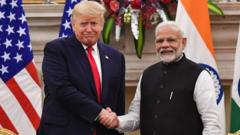Amid escalating negotiations between India and the United States, the prospect of a trade deal seems increasingly precarious as the 9 July deadline approaches. Both governments remain optimistic about the potential for an interim agreement, yet key challenges persist, notably in the agricultural sector and tariff regulations.
Recent statements from both Indian Finance Minister Nirmala Sitharaman and White House Press Secretary Karoline Leavitt have painted a hopeful picture of imminent progress. Yet, both sides are entrenched in hard bargaining, particularly around sensitive topics including agricultural access, auto parts, and tariffs on Indian steel products. Indian negotiators have decided to extend their stay in Washington for additional discussions, indicating that the stakes are high, but "very big red lines" regarding farm protections remain.
The urgency of the situation is highlighted by trade experts like Ajay Srivastava, who assert that the next week could determine whether a limited trade deal emerges or if negotiations stall. With the Indian government prioritizing the protection of its agricultural sector for economic stability and political reasons, significant contention is expected over market access for basic agricultural products.
South Asian analysts like Richard Rossow explain that the more formidable barrier in the trade talks stems from India's stringent non-tariff barriers and product quality regulations. The US has expressed concern about over 700 Quality Control Orders that India has enacted, which restrict low-quality imports and are part of their broader economic strategy.
On the agricultural front, US demands for broader market access stand in contrast to India's longstanding commitment to its farmers, whose livelihoods depend on price supports and procurement policies. Both countries currently engage in limited agri-trade valued at about $8 billion, with a focus on diverse exports such as rice and shrimp from India and nuts and apples from the US. However, increased US exports of corn and soya beans are seen as critical to addressing its significant trade deficit with India.
Experts caution that any compromises regarding tariffs could jeopardize India’s essential agricultural safeguards, especially in the domain of dairy products and staple grains, which collectively comprise a vital support system for millions of farmers.
Furthermore, Indian policy recommendations from various economic think tanks hint at a willingness to consider limited tariff reductions on certain US agricultural imports. However, there remains skepticism regarding whether these recommendations accurately reflect official government policy or merely propose potential avenues for discussion.
As negotiations continue, the probability of a narrowed focus on a "mini-deal" emerges. This prospective agreement may entail limited tariff concessions on various industrial items, particularly automobiles, alongside some agricultural access deals for specific products. Enhanced US demands are likely to extend to significant purchases of American goods, including energy supplies and advanced technologies, creating additional dimensions to the trade discussions.
Initially fueled by a clear vision for mutual benefit, the negotiations have become increasingly complex, straying from the straightforward framework laid out by President Trump and Prime Minister Modi earlier this year. Failure to reach an agreement could lead to the imposition of tariffs or other trade restrictions. However, analysts suggest that targeting India individually may not be politically advantageous for the Trump administration. As this intricate situation unfolds, the future of India-US trade relations remains uncertain.





















